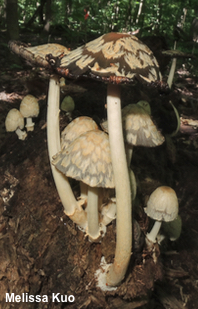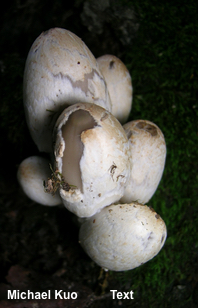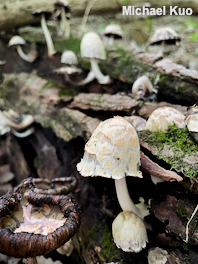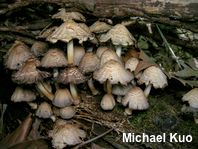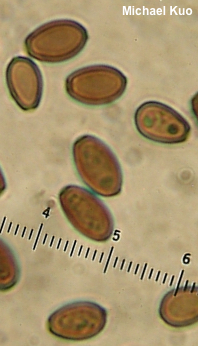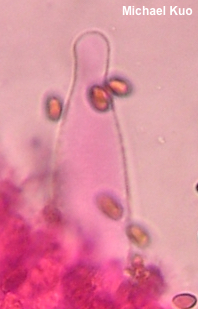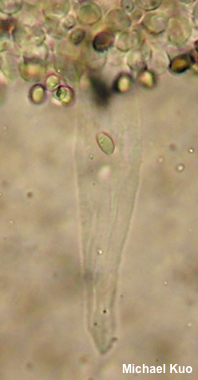| Major Groups > Gilled Mushrooms > Dark-Spored > Coprinoid Mushrooms > Coprinopsis variegata |

|
[ Basidiomycota > Agaricales > Psathyrellaceae > Coprinopsis . . . ] Coprinopsis variegata by Michael Kuo, 23 June 2024 Coprinopsis variegata is an impressive woodland coprinoid mushroom that fruits in large clusters on decaying hardwood logs in eastern North America. Unlike many of its inky, coprinoid friends, Coprinopsis variegata is fairly substantial and distinctive, sporting an array of large veil patches on its cap. American mycological pioneer C. H. Peck described and named three very similar species over a period of 24 years in the late 1800s: Coprinus variegatus, Coprinus ebulbosus, and Coprinus quadrifidus. However, the differences between Peck's species, through today's lenses, do not necessarily reflect speciation, leading Patrick (1979) to synonymize the the putative species, leaving variegatus, the oldest of Peck's three names, as the correct name for the species. Contemporary DNA-based research has not investigated Peck's type collections of these species, to my knowledge, though a preliminary, single-gene alignment (Douglas et al. 2020) found considerable phylogenetic separation between collections identified as "Coprinus quadrifidus" and "Coprinus variegatus" in GenBank. The Douglas study investigates whether or not Coprinopsis strossmayeri and several other species in this group should properly be separated or lumped together, concluding that further research is required. Coprinopsis variegata, however, is clearly distinct, both morphologically and ecologically, from Coprinopsis strossmayeri. Ecologically, the former species grows in woods, on well decayed hardwood logs; the latter grows in urban areas, in woodchips, on stumps of recently cut trees or, especially, from the dead or dying root systems of recently cut trees, appearing "terrestrial." Morphologically, variegata buttons are completely encased in a universal veil that soon begins to split apart into large patches; the strossmayeri veil, in contrast, is more conspicuously fibrillose and breaks apart into much smaller scales. Additionally the stem bases are different: in variegatus the base often terminates in a fairly large rimmed bulb, inserted into the woody substrate (leading Peck to name it "ebulbosus" in one of his three namings of this mushroom); the stem base in strossmayeri is usually not swollen, and is attached to reddish brown rhizomorphs. Finally, under the microscope, variegata often features both "normal" and thick-walled, "metuloid" pleurocystidia, while strossmayeri never features metuloids. Coprinus variegatus, Coprinus quadrifidus, and Coprinus ebulbosus are synonyms. Description: Ecology: Saprobic, growing in large clusters or closely gregariously on well-decayed hardwood logs in woodland ecosystems; summer and fall; originally described from New York (Peck 1873); widely distributed east of the Rocky Mountains. The illustrated and described collections are from Illinois, Iowa, and Wisconsin. Cap: 3–8 cm across; when young oval and covered entirely by a felty, whitish and yellowish universal veil; soon expanding to bell shaped, with the veil breaking up into large felty patches to reveal a smooth, brownish yellow surface underneath; eventually broadly bell shaped, with a grayish surface, the margin becoming grooved, curling upward, and splitting. Gills: Narrowly attached to the stem or free from it; crowded; white at first, becoming grayish, then black; eventually liquefying. Stem: 5–13 cm long; up to 1 cm thick; tapered slightly to apex; terminating in a rimmed basal bulb that is inserted into the wood. Flesh: Thin; white; unchanging when sliced. Odor: Not distinctive. Spore Print: Black. Microscopic Features: Spores 6–10 x 4–5.5 µm; ellipsoid, with a pore 0.5–1 µm across; smooth; brown in KOH. Basidia 18–22 x 6–7 µm; 4-sterigmate; surrounded by brachybasidioles. Pleurocystidia dimorphic: either 75–125 x 15–25 µm, subfusiform to lageniform or subutriform, smooth, thin-walled, hyaline in KOH—or metuloid, 100–125 x 15–20 µm, fusiform, smooth, very thick walled (up to 5 µm thick), hyaline in KOH. Veil elements more or less cylindric; up to 15 µm wide; branching; occasionally diverticulate. Clamp connections present. REFERENCES: (C. H. Peck, 1873) S. A. Redhead, R. J. Vilgalys & J. -M. Moncalvo, 2001. (Kauffman, 1918; Graham, 1944; Patrick, 1979; Smith, Smith & Weber, 1979; Weber & Smith, 1985; Arora, 1986; Phillips, 1991/2005; Lincoff, 1992; Horn, Kay & Abel, 1993; Barron, 1999; Roody, 2003; McNeil, 2006; Miller & Miller, 2006; Kuo & Methven, 2014; Woehrel & Light, 2017; Baroni, 2017; Sturgeon, 2018; Douglas et al., 2020; McKnight et al., 2021.) Herb. Kuo 06070301, 07100305, 06090701, 07050704, 07301601, 07122301. This site contains no information about the edibility or toxicity of mushrooms. |
© MushroomExpert.Com |
|
Cite this page as: Kuo, M. (2024, June). Coprinopsis variegata. Retrieved from the MushroomExpert.Com Web site: http://www.mushroomexpert.com/coprinopsis_variegata.html |
